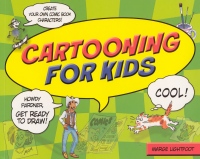| ________________
CM . . .
. Volume XI Number 18 . . . .May 13, 2005
excerpt:
Guaranteed to be a hit with kids, Cartooning for Kids does a great job of encouraging even the least artistic of them to draw cartoons and comics. The author suggests that aspiring cartoonists should record their ideas—gleaned from personal experience in their daily lives, observing people and daydreaming—in a notebook or recipe card file for inspiration. Topics in the book include how to draw people, animals and background scenery. Using simple language and easy-to-follow instructions, Lightfoot teaches readers how to break the human—or animal—figure down into a series of basic shapes—circles, ovals, pears and triangles. She provides tips on creating a sense of movement with action lines, using symbols (e.g. tears, hearts, beads of sweat) and body positions to express feelings, and adding texture and colour for interest. As well, she shows how the addition of small details can make a drawing come alive. Broken lines, for instance, can instantly convert a pair of pants into jeans by conveying stitching, while curved lines indicate a billowy fabric. There are suggestions for purchasing art supplies, using visual gags, arranging speech balloons for sequence and visual balance, and changing angles in a cartoon strip to avoid monotony. Lightfoot shows, by example, when it is best to use one frame to tell a story and when multiple frames would be more suitable. Helpful diagrams, hints, and plenty of examples demonstrate the techniques and concepts presented. The book's final chapter provides ideas for related art projects such as greeting cards, flip books, posters and stationery, as well as painted rocks, holiday-themed windows and fabric-painted t-shirts. A colourful, eye-catching cover, abundant illustrations and an attractive layout enhance this book's appeal. Perfect for beginners, kids who like to draw and even the "artistically challenged," this book is definitely worthy of purchase. Highly Recommended. Gail Hamilton is a teacher-librarian at Bird's Hill School in East St. Paul, MB.
To comment
on this title or this review, send mail to cm@umanitoba.ca.
Copyright © the Manitoba Library Association. Reproduction for personal
use is permitted only if this copyright notice is maintained. Any
other reproduction is prohibited without permission.
NEXT REVIEW |
TABLE OF CONTENTS FOR THIS ISSUE
- May 13, 2005.
AUTHORS |
TITLES |
MEDIA REVIEWS |
PROFILES |
BACK ISSUES |
SEARCH |
CMARCHIVE |
HOME |
